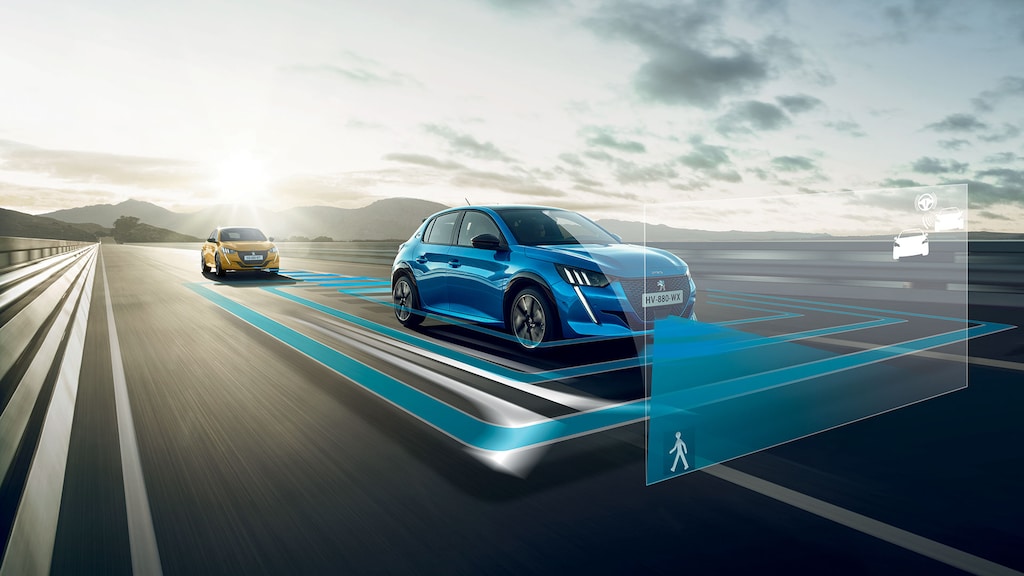
SAFETY AIDS
This function is particularly suited to driving conditions on the motorway in semi-dense or flowing traffic, avoiding the systematic disconnection of the cruise control each time a vehicle is in front. Indeed, as soon as the radar detects a vehicle, a constant gap is maintained by automatically reducing the speed of the vehicle to 20 km/h thanks to the engine braking by action on the accelerator. When the lane becomes free, the cruise control resumes the speed initially requested. If the 20 km/h deceleration is not sufficient to maintain the gap, the cruise control alerts the driver and returns control of the speed to the driver.
Automatic maintenance of the vehicle speed at the value programmed by the driver
Automatic adjustment of the distance with the vehicle which ahead of you (3 predefined levels: far, normal and close)
This system detects a vehicle traveling in front of it in the same direction of traffic. It automatically adapts the speed of the vehicle to that of the vehicle in front, using the engine brake and the braking system (the brake lights then come on), to maintain a constant distance until the complete stop of the vehicle (for a vehicle fitted with an automatic gearbox) or up to 30 km/h (for a vehicle fitted with a manual gearbox) .
With its knob placed on the central console, Grip Control widens the field of use of the vehicle thanks to adapted traction in poor grip conditions. This patented system works in concert with a specific adapted tire assembly.
Versatile and flexible, the Grip Control optimizes traction according to the terrain taken by acting on the front wheels. The system always leaves control to the driver. The latter can indeed at any time rely on the intelligence of this equipment, thanks to the Standard mode, or select the desired mode via the wheel:
- Standard mode is intended for normal road conditions with low wheel slip.
- Snow mode instantly adapts the slippage of each of the front wheels to the grip conditions encountered. As soon as the vehicle speed reaches 50 km/h, the system switches to Standard mode.
- Off-Road mode allows you to move serenely on slippery ground (mud, wet grass, etc.). It ensures that the vehicle starts in these particular conditions by transferring the maximum possible torque to the gripping wheel. Acting as a limited slip differential (DGL), it is particularly suitable for roads and active up to 80 km/h.
- Sand mode retains slippage on both drive wheels simultaneously to allow progress on soft ground and limit the risk of silting up. This mode is functional up to 120 km/h then switches to Standard mode.
- ESP Off mode gives the driver the freedom to completely disconnect ESP and Grip Control, up to 50 km/h, and to manage traction completely independently.

The "Advanced Grip Control" enhanced traction system benefits from the following equipment:
- Optimized traction control with these five grip modes (Normal, Snow, Mud, Sand, ESP Off) controlled by a wheel located on the central console
- Specific 18'' M+S tire (Mud & Snow)
- Hill Assist Descent Control (HADC), a new descent assistance function allowing perfect and safe control of the vehicle and its trajectory on steep slopes. The system is innovative because it can keep the vehicle at a very low speed (3 km/h), providing control and safety in situations known to be anxiety-provoking.
This function can be activated via a dedicated push button on the center console for speeds below 70 km/h. Below 30 km/h, the system becomes active.
In the event of a slight slope or in the absence of difficulty, the driver can release the accelerator and brake pedals. If the gearbox is engaged in first or second gear, the speed is regulated.
In the event of a steep slope and/or difficulty of evolution, the HADC function can be activated by switching to neutral. The speed maintained downhill is lower to improve safety.
The HADC function adapts according to the slope:
- between 5 and 8%, the function converges towards a speed of 17 km/h
- greater than 8%, the function regulates the speed between 3 and 17 km/h
Active Safety Brake (automatic emergency braking) intervenes after the alert, if the driver does not react quickly enough and does not apply the vehicle brakes. It thus contributes, without driver action, to avoiding a collision or limiting its severity by reducing the speed of the vehicle. Registered vehicles traveling in the same direction of traffic or stationary are taken into account by the system, as well as pedestrians present on the lane (cycles, motorcycles, animals and objects on the roadway are not detected ). The Active Safety Brake operates if:
- The vehicle speed is between 5 km/h and 140 km/h when a moving vehicle is detected.
- The vehicle speed does not exceed 80 km/h when a stationary vehicle is detected.
- The vehicle speed must not exceed 60 km/h when a pedestrian is detected.
This system works in conjunction with Active Lane Departure Warning: in addition to the fixed indicator light in the rear view mirror on the side concerned, a trajectory correction will be felt if a line is crossed with the direction indicator light activated, to help the driver to avoid a collision.
